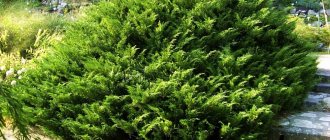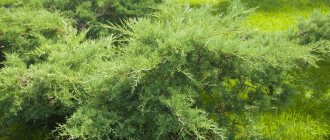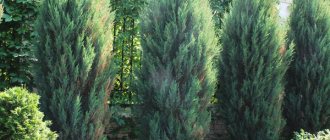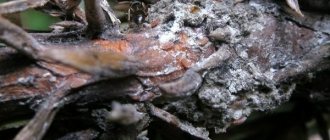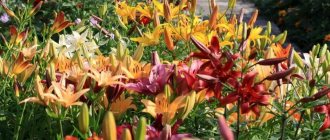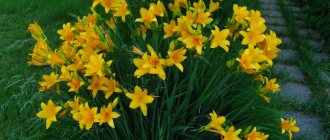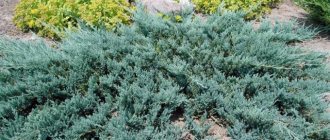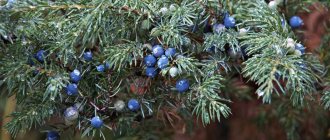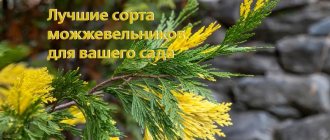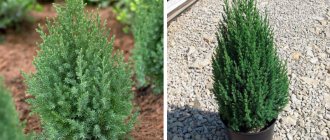Bushes and trees
0
330
Article rating
Kira Stoletova
Cossack juniper (name in Latin - Juniperus sabina) has gained popularity due to its unpretentiousness: of all the representatives of its family, it is the easiest to care for.
Juniper Cossack: a variety of varieties for any garden
The variety is grown both in open ground and at home. It is used to create bonsai and topiary on a trunk.
Brief information about the species
- Needle color : blue, green, gray.
- Height : on average up to 1.5 m, most varieties are lower.
- Crown diameter : depends on the variety, maximum – 8 m.
- In which regions does it grow?:
- Planting characteristics : light-loving crop, resistant to air pollution. Does not tolerate salty soils well. Do not plant next to roses and plums.
- Immunity : the strongest among junipers. The main diseases are fusarium, brown schutte, biatorella cancer. Carrier of net rust.
- Life expectancy : over 20 years.
Description of varieties
Today there are about 70 varieties of Cossack juniper, some are listed in the Red Book.
Any of them is useful in the fight against moths: its branches have a pungent odor that insects cannot tolerate.
The plant is poisonous, therefore it is used in pharmacology in the form of medicinal ointments and tinctures used externally. The plant is suitable for creating crafts and applied products (for example, fishhooks).
For landscape design, the following varieties are most often chosen.
Tamariscifolia is a dwarf bush with long branches. By 10 years it has a height of up to 0.3 m and a crown width of up to 2 m.
It grows along the ground, with creeping shoots when young. It has thick needle-shaped needles of a grayish-green color, sometimes with a bluish tint.
Tamaris has low soil and moisture requirements and grows well in both sun and partial shade. Per sq.m. plant up to 3 plants
Glauca is a spreading bush. Maximum height 1 m, width – 2 m. The needles are blue-green, scaly, turning red in winter. has bluish berry cones.
Arcadia is a perennial dwarf plant. By the age of 10, it reaches a height of 0.3 m and a width of up to 2 m. It has a dense crown and scaly needles from light green to blue and gray shades.
Cossack juniper has more than 70 varieties
It exhibits its decorative properties with ample light and well-drained soil.
Hicksii is a lush, spreading bush up to 1.3 m high. The needles are mostly blue-green and sharp.
Blue Danube is a spreading low shrub that grows moderately fast. By the age of 10, the height is 1 m, crown diameter is 1.5 m.
The ends of the branches rise upward, the crown is bowl-shaped, loose. The needles are scaly, pointed, gray-blue or green-blue. Prefers light; in the shade it loses its decorative effect.
Rockery Gem was developed in Holland. Height by 5 years is up to 0.5 m, width - over 3 m. The branches are straight, the needles are green and sharp.
Blue Sparkle . By the age of 10, the height is up to 1 m, width is up to 1.5 m. The needles are green-blue.
Broadmoor . Up to 0.5 m high, up to 3.5 m wide. The needles are gray-blue, curly, with a strong odor. The crown is very dense and easily survives pruning.
Blaue Donau . Height up to 1 m, width up to 2 m. Recumbent branches rise towards the end. The needles are green-yellow in spring, becoming bluish in winter.
Mas (Mas) is a poisonous juniper. Height up to 2 m, crown width up to 8 m. Average growth rate, grows well horizontally: up to 20 cm annually. By the age of 10, it has a crown 1.5 m wide and 0.5 m high.
According to the description of gardeners, this is a spreading bush with a beautiful crown. The color of the needles is bluish, acquiring a purple tinge in winter.
It tolerates frost well, but does not like soil salinity and stagnant water. It prefers light, which is where it exhibits its decorative properties.
Variegata. Its name is translated from Latin as “motley”.
It is characterized by slow growth, by the age of 10 it has a height of 0.4 m and a crown width of 1 m. The needles are scaly, greenish, the ends of the shoots are yellow or cream. Their tops bend and rise.
In hot and cold weather, the needles sometimes become brownish in color. It is demanding of light, but does not like midday sun, does not tolerate wind well, the plant must be covered for the winter.
Erecta. It has a pyramidal shape and grows over 2 m. The needles are dark, green, and scaly. Easily tolerates heat and drought. Propagated well by cuttings at home.
Femina. Up to 1.5 m in height, up to 5 m in width. The needles are thick, dark green, exude an unpleasant odor and are poisonous. Growth is slow. Frost-resistant, durable.
Knap Hill . Up to 1.5 m in height and width. The needles are soft, blue-green. There is resistance to frost, disease and salt, and shade tolerance.
Tam no Blight . Height up to 1.5 m, diameter up to 2.5 m. The needles are gray-green, occasionally with a bluish bloom.
Moona . Low growing, with green-blue soft needles. prefers sun and moderate humidity.
Pruning and shaping the bush
For better growth and to give the juniper a decorative appearance, it undergoes sanitary and formative pruning. Initially, it is done 1-2 years after planting the bush - damaged, withered shoots are cut out.
It is advisable to carry out formative pruning annually, twice - in April and in August or in early autumn, in September. Juniper is a poisonous plant, so all work must be carried out using protective equipment to avoid direct contact with harmful substances. Thoroughly wipe the secateurs and scissors after work.
Giving the bush its shape is done by pinching off the tips of new shoots - this will allow you to form a fluffy bush. Incorrectly growing shoots are given direction by tying them down and stimulating growth in the right direction.
You can form a bonsai-style shrub by pruning to direct the growth of branches in the desired direction. Usually 10-20% of the annual growth is pruned. After trimming, the wounds can be covered with resin and treated with stimulants such as Zircon and Epin.
Landing
The plant does not take root well, so it is worth paying special attention to the preparation of the seedling and the location.
Selection and preparation of seedlings
Good seedling:
- Has no dried branches.
- The bark is intact, without growths or suspicious inclusions.
- It has a dense earthen lump.
Sometimes, instead of Cossack juniper, they may sell false Cossack juniper. You can distinguish it by the color of the needles: the real one is brown, the other one is gray.
An easy way to root a healthy seedling is to pre-soak its root system in growth stimulants.
Before planting the plant, it is kept in a tray with water for 2-2.5 hours so that the earthen lump sets.
Preparing the site
Juniper needs sunlight
Most plant varieties prefer places without stagnant moisture with good lighting. The minimum distance between bushes is 0.5 m.
The planting hole is made 3 times larger than the earthen ball. Its bottom is lined with drainage, using a mixture of sand and brick fragments. Drainage height – 20 cm.
The roots are sprinkled with a mixture that you prepare yourself. It consists of peat, turf and sand in a ratio of 2:1:1.
Landing technology
It is recommended to plant in open ground in April or September while maintaining high air humidity.
When planting adult plants, the root collar is not buried. For young people it is left at ground level
After the procedure, the juniper is watered abundantly.
Transplanting a plant
If possible, do not transplant to another place. An adult plant tolerates this procedure extremely poorly.
If the need arises, then you must follow the recommendations.
- Inspect the juniper for diseases or mechanical damage. They weaken the immune system and significantly reduce the survival rate in a new place.
- 6 months before transplanting, dig up the plant, cutting to the diameter of the crown. Versions with vertical growth are dug around the diameter of the double crown, if possible.
- Having dug up the bush, its roots are watered with a growth stimulator.
- After this, you can plant the plant in another place, prepared in advance.
- Juniper is watered abundantly. You should not allow the code to get on the crown, which is especially important for creeping varieties.
Care
Cossack juniper is not demanding in terms of care, but it must be trimmed to avoid creating dense thickets on the site.
Watering
Watering is required only in dry weather, but you should not water more than 4 times per season. 10-30 liters of water are poured under one bush, depending on the size of the plant.
Juniper is sprayed once a week. The procedure is carried out in the absence of sun.
Feeding
The plant is fed with nitroammophoska in mid-April to late May. You can use Kemira station wagon.
If the bush turns yellow, then additional fertilizer is allowed.
Mulching and loosening the soil
Peat, wood chips, and pine bark are used as mulch. To protect the root system, a layer 8 cm high is sufficient.
The soil of young plants must be loosened superficially. Additional air flow to the roots helps the young growth to gain a foothold in a new place.
Haircut and trimming
Juniper does not require mandatory pruning; it is mainly done for sanitary purposes. Using garden shears, remove dead or diseased shoots.
Formation is also carried out to:
- change the direction of plant growth;
- stop growth;
- create a decorative look.
Cossack juniper responds well to pruning to change its appearance.
In spring it is necessary to remove all dry shoots
Shaping is planned for spring or autumn. It is important that the average air temperature per day does not exceed 4 °C. The removal rate is no more than 2 cm.
There is no need to cover the cut areas. In case of severe or extensive damage, the branches are sprayed with Epin. Sometimes they are treated with resin.
Gardeners advise using pinching rather than pruning. This method is considered softer and more preferable; it enhances branching, making the crown more luxuriant.
Please note that before trimming the juniper, you must wear gardening gloves, as the sap is poisonous.
How to plant
Planting Cossack juniper should not pose any particular difficulties even for a novice gardener, since this plant is distinguished by its high adaptive ability.
The main thing is to choose a suitable location with deep groundwater and good drainage capacity of the soil.
Landing dates
By the time of planting, the soil temperature should reach 5 ° C, the soil should be sufficiently dry . You can plant a bush either in mid-spring or in mid-autumn.
Site selection and soil preparation
The requirements for the landing site are very simple:
- The site should be located on a hill to prevent close groundwater.
- The place is well lit, light partial shade is possible only during the midday hours.
- The soil on the site is loose, well-drained, and nutritious.
Note! If nettles grow on the site, then the soil is suitable for juniper. No additional fertilizer is required.
For clay soils, a mandatory step in preparing for planting a juniper bush will be the addition of several buckets of coarse river sand.
Humus and peat are added to depleted soils . The area is well dug up and the roots of weeds are removed before planting juniper.
What can be planted nearby?
Juniper has a peaceful disposition and does not conflict with its neighbors . Its high decorative qualities make it possible to place the bush both in a flower garden and among ornamental shrubs.
However, it is worth considering that Cossack juniper tends to grow in width, so it needs to be planted in a sufficiently large empty space, placing other plants at a distance of at least 1.5 meters.
Landing rules
Before planting in a permanent place, the juniper bush must be prepared. Carefully inspect the plant, cut off all damaged and yellowed shoots, remove stunted roots , etc.
Dissolve the root formation stimulator in a bucket of water and soak the roots in this solution for 2–3 hours.
To plant juniper, you need to follow the sequence of actions:
- The area is dug up in advance, weed roots and large stones are removed.
- Dig a planting hole of such a size that the juniper root ball fits completely into it and there is free space left. A drainage layer of small pebbles or broken bricks must be laid at the bottom.
- A seedling is planted, sprinkling the free space with a mixture of turf soil, peat, humus and sand.
- The planting is compacted and watered abundantly.
- The space around the bush is mulched.
Transfer
Juniper does not need replanting.
A plant that has not reached 10 years of age can still be moved to a new location in exceptional cases (the site is flooded or construction is planned on this site), but an older plant most likely will not tolerate replanting .
Reproduction
There are four ways to propagate Cossack juniper.
- Using seeds. The method is little used outside nurseries, since the seeds require mandatory stratification.
- Cuttings. Gardeners advise carrying out the procedure in mid-April or early August. It is best if the weather is cloudy for a couple of days beforehand. Then sunlight will not harm the mother plant and will facilitate the whole process. It is important to remember that juniper is poisonous: work with cuttings only with protective gloves.
- By layering. The method is suitable for creeping plants with new shoots. The branches close to the soil are pressed with pins or wooden forks, sprinkled with earth and occasionally watered. Rooted cuttings are cut off from the mother tree and transplanted to another place.
- Vaccination. With this method, the required variety is grafted, fixed with film and waiting for engraftment.
The whole process is complicated by extremely slow growth. In this regard, gardeners prefer to purchase seedlings from nurseries.
Juniper berries and oil are toxic! ↑
Ephedra shoots are endowed with essential oil - sabinol. We must not forget about the toxicity of the plant.
Even in ancient times, one of the founders of botany, Dioscorides, mentioned the ephedra. Interestingly, sabinol oil, contained in the branches and cones of the plant, has an abortifacient effect.
There is a legend that the species got its name from the name (Sabina) of the riotous woman who discovered this property. In some countries, a ban has even been imposed on planting the species in public places.
Severe uterine bleeding is also caused by Cossack juniper berries. Poisoning with berries can cause convulsions and even paralysis. Therefore, it is strictly forbidden to eat them, unlike common juniper berries, which are used in preparing dishes and drinks.
Diseases and pests
Compared to other representatives of the genus, Cossack juniper has the strongest immunity. However, he is also susceptible to some diseases.
- Rust mushroom. The tree is its intermediate host; the disease is chronic and practically untreatable. When affected, the needles begin to dry out and acquire a brown tint. Fungicides are considered the main control method - they are used twice with an interval of 15 days.
- Brown Schutte. It is also a disease caused by fungi and occurs with high humidity. To prevent the disease, it is recommended to remove all affected needles and promptly spray with 1% Bordeaux mixture in spring and autumn.
- Biatorella cancer. Appears when branches are broken or the bark is damaged; young plants and seedlings are at risk. For prevention, gardeners advise paying attention to the quality of planting material. If a problem occurs during planting, the fractures are treated with 1% copper sulfate solution, after which they are lubricated with drying oil, varnish or oil paint. The affected parts are cut off and burned.
- Fusarium. Under its influence, the root system rots. Spreads along with planting material or infected soil. To prevent the disease, seedlings are soaked in solutions of Baktofit or a similar preparation, adult plants are watered with 0.2% Fundazol and the crown is sprayed with it. Prchva is treated with Fitosporin-M, or Gamair.
Cossack juniper is resistant to pests.
Diseases of Juniper Cossack
The most common disease is rust , which manifests itself in the form of small formations of a reddish hue on the shoots, caused by basidiomycetes. The infected shoot is immediately removed and then treated with Topaz or other fungicidal compounds. The bush is also often damaged by the disease tracheomycosis, which is difficult to recognize. The only sign is wilting of the leaves. For control, the soil is treated with Alirin-B or Fitosporin-M.
Tracheomycosis , is no less dangerous for the plant . This disease occurs as a result of excess moisture in the soil (water stagnation). Visually, you can notice the drying out of the upper shoots, where the needles turn orange. If the bush is not treated, it will die. How to fight the disease? Remove dried branches, replant the bush, and remove the soil from the garden (it is contaminated with fungus). Treat the plant with fungicides before planting. It is advisable to disinfect the roots by soaking them in a solution of the drug Maxim for 2–3 hours.
Schutte brown is another common disease of most Juniper species. The disease manifests itself in early summer with a change in the color of the needles to brown. At the end of summer, round or oval spots (apothecia) appear on infected needles. If a change in the color of the needles is detected at the end of spring, it is imperative to remove the infected branches and treat the bush with a fungicide (again in the fall).
Pests of coniferous shrubs Cossack juniper
Among the pests, the most harmful are sucking parasites: mites, scale insects, moths and aphids. Plants should be regularly inspected for the presence of these pests and immediately take measures to remove them. Also worth noting are Gall midges (small mosquito-like insects). They sit on the branches of a plant and lay their eggs (galls). If galls are detected, the shrub should be treated with fungicides and the infected needles removed.
If you notice a web on a Juniper, your shrub is attacked by a spruce spider mite. Prevention will protect you from this parasite. Periodically spraying the plant with water during the dry season can stop the appearance of the insect. If you find a cobweb, you should treat the bush with acaricides.
Use in landscape design
Cossack juniper has a pleasant crown color and small size, which is why it is used by landscape designers everywhere.
- It is planted as a tapeworm.
- They decorate lawns, slopes, rocky hills and flower beds.
- It is used to form a hedge.
- It is used to create complex compositions and shade other plants in group plantings.
Landscape designers note that this juniper goes well with brightly colored perennials.
At the same time, against the backdrop of lush vegetation and massive flowers, it does not look attractive. The situation does not change during the flowering period of the latter.
Large varieties are planted to create a landscape style, which is also called English.
In this case, it is important to choose a shrub with a calm tone of needles and the right crown. When composing a composition, this juniper is placed in the background, without placing any special emphasis on it.
For discreet Japanese gardens, strict varieties are used that create contrast for bright and unusual plants.
When decorating, it is recommended to plant conifers close to ordinary heather of various shades, or use Sabina to decorate rocky hills.
Cossack juniper is a bad neighbor for plums and rosaceae, since it is a carrier of fungi that cause net rust.
In addition to traditional planting in open ground, topiary is formed from it. The use of the form varies: from decorating attics and gazebos to growing at home.
When cutting them to form a crown, you need to wear gloves.
Topiaries, like niwaki (bonsai), are attractive things, but they cannot be kept indoors all the time. Gardeners advise taking plants out into the air as often as possible.
Place on the site ↑
- The plant is perfect for hedges.
- It will be an addition to the arsenal of plants in a rocky garden.
- Crowded group plantings can be placed on a spacious green lawn.
- Coniferous bushes are sources of not only extraordinary beauty, but also a real storehouse of benefits for the site. Drooping branches take root well and form a kind of reinforcing net for the layers of soil. If planted on slopes or near groundwater, the roots of the plants will perfectly strengthen the soil, which will prevent erosion.
- Plants can be used to create wide borders along paths and paths.
No matter how beautiful it is, if there are small children growing up in the house, it is better to choose a different type of juniper. Because of its berries and stems, Cossack juniper is included in the group of 15 most toxic garden plants. And among the huge selection of juniper species, you can always find the one that suits you perfectly.
Reviews
Landscape designers speak positively about the Cossack variety.
Nurseries set low prices for seedlings, but the decorative properties of the plant are very great: it can be planted throughout the site in a variety of compositions.
Juniper is used as a ground cover crop, to decorate hills, along with a variety of flowers as a background.
When planting, it is important to understand that it must be trimmed regularly: it grows extremely quickly and forms dense thickets.
